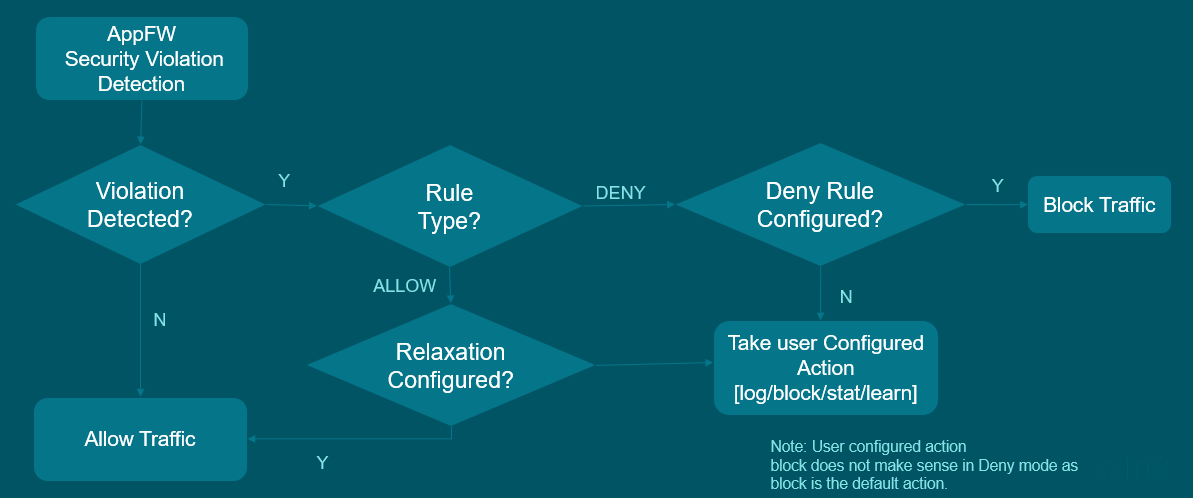Relaxation and deny rules for handling HTML SQL injection attacks
When there is an incoming traffic, the violation detection logic checks for traffic violations. If no HTML SQL injection attacks are detected, the traffic is allowed to pass. But if a violation is detected, the relaxation (allow) and deny rules define how to handle the violations. If the security check is configured in the allow mode (default mode), the detected violation is blocked unless the user has explicitly configured a relaxation or allow rule.
In addition to allow mode, the security check can also be configured in deny mode and use deny rules for handling violations. If the security check is configured in this mode, the detected violations are blocked if a user has explicitly configured a deny rule. If there are no deny rules configured, then the user configured action is applied.
The following illustration explains how to allow and deny modes of operation work:

- When a violation is detected, the relaxation (allow) and deny rules define how to handle the violations.
- If the security check is configured in deny mode (if configured in allow mode, jump to step 5), the violation is blocked unless you have explicitly configured a deny rule.
- If the violation matches a deny rule, the appliance blocks the traffic.
- If the traffic violation does not match a rule, the appliance applies a user-defined action (block, reset, or drop).
- If the security check is configured in allow mode, the Web App Firewall module checks if there are any allow rule configured.
- If the violation matches an allow rule, the appliance allows the traffic to bypass otherwise, it is blocked.
At the command prompt, type:
set appfw profile –SQLInjectionAction [block stats learn] – SQLInjectionRuleType [ALLOW DENY]
Example:
set appfw profile prof1 sqlInjectionAction block -sqlInjectionRuleType ALLOW DENY
Bind relaxation and enforcement rules to Web Application Firewall profile
At the command prompt, type:
bind appfw profile -SQLInjection
Example:
bind appfw profile p1 -SQLInjection field_f1 "/login.php" –RuleType ALLOW
bind appfw profile p2 -SQLInjection field_f1 "/login.php" –RuleType ALLOW
The official version of this content is in English. Some of the Cloud Software Group documentation content is machine translated for your convenience only. Cloud Software Group has no control over machine-translated content, which may contain errors, inaccuracies or unsuitable language. No warranty of any kind, either expressed or implied, is made as to the accuracy, reliability, suitability, or correctness of any translations made from the English original into any other language, or that your Cloud Software Group product or service conforms to any machine translated content, and any warranty provided under the applicable end user license agreement or terms of service, or any other agreement with Cloud Software Group, that the product or service conforms with any documentation shall not apply to the extent that such documentation has been machine translated. Cloud Software Group will not be held responsible for any damage or issues that may arise from using machine-translated content.
DIESER DIENST KANN ÜBERSETZUNGEN ENTHALTEN, DIE VON GOOGLE BEREITGESTELLT WERDEN. GOOGLE LEHNT JEDE AUSDRÜCKLICHE ODER STILLSCHWEIGENDE GEWÄHRLEISTUNG IN BEZUG AUF DIE ÜBERSETZUNGEN AB, EINSCHLIESSLICH JEGLICHER GEWÄHRLEISTUNG DER GENAUIGKEIT, ZUVERLÄSSIGKEIT UND JEGLICHER STILLSCHWEIGENDEN GEWÄHRLEISTUNG DER MARKTGÄNGIGKEIT, DER EIGNUNG FÜR EINEN BESTIMMTEN ZWECK UND DER NICHTVERLETZUNG VON RECHTEN DRITTER.
CE SERVICE PEUT CONTENIR DES TRADUCTIONS FOURNIES PAR GOOGLE. GOOGLE EXCLUT TOUTE GARANTIE RELATIVE AUX TRADUCTIONS, EXPRESSE OU IMPLICITE, Y COMPRIS TOUTE GARANTIE D'EXACTITUDE, DE FIABILITÉ ET TOUTE GARANTIE IMPLICITE DE QUALITÉ MARCHANDE, D'ADÉQUATION À UN USAGE PARTICULIER ET D'ABSENCE DE CONTREFAÇON.
ESTE SERVICIO PUEDE CONTENER TRADUCCIONES CON TECNOLOGÍA DE GOOGLE. GOOGLE RENUNCIA A TODAS LAS GARANTÍAS RELACIONADAS CON LAS TRADUCCIONES, TANTO IMPLÍCITAS COMO EXPLÍCITAS, INCLUIDAS LAS GARANTÍAS DE EXACTITUD, FIABILIDAD Y OTRAS GARANTÍAS IMPLÍCITAS DE COMERCIABILIDAD, IDONEIDAD PARA UN FIN EN PARTICULAR Y AUSENCIA DE INFRACCIÓN DE DERECHOS.
本服务可能包含由 Google 提供技术支持的翻译。Google 对这些翻译内容不做任何明示或暗示的保证,包括对准确性、可靠性的任何保证以及对适销性、特定用途的适用性和非侵权性的任何暗示保证。
このサービスには、Google が提供する翻訳が含まれている可能性があります。Google は翻訳について、明示的か黙示的かを問わず、精度と信頼性に関するあらゆる保証、および商品性、特定目的への適合性、第三者の権利を侵害しないことに関するあらゆる黙示的保証を含め、一切保証しません。
ESTE SERVIÇO PODE CONTER TRADUÇÕES FORNECIDAS PELO GOOGLE. O GOOGLE SE EXIME DE TODAS AS GARANTIAS RELACIONADAS COM AS TRADUÇÕES, EXPRESSAS OU IMPLÍCITAS, INCLUINDO QUALQUER GARANTIA DE PRECISÃO, CONFIABILIDADE E QUALQUER GARANTIA IMPLÍCITA DE COMERCIALIZAÇÃO, ADEQUAÇÃO A UM PROPÓSITO ESPECÍFICO E NÃO INFRAÇÃO.

